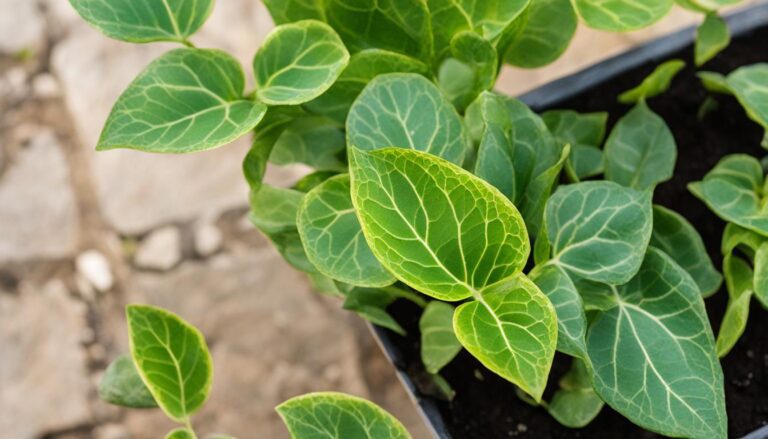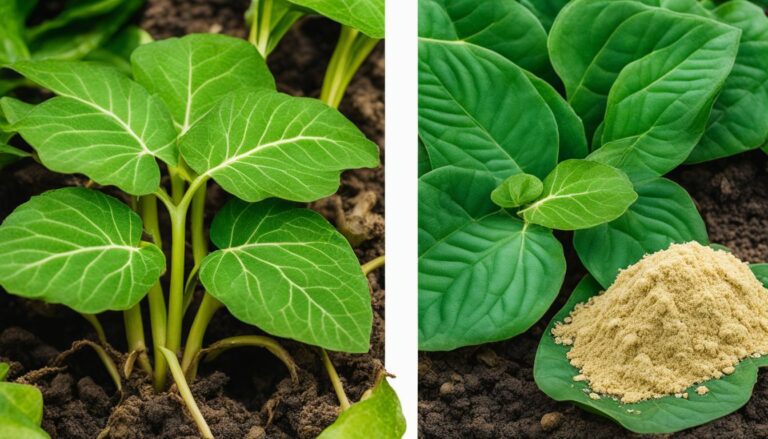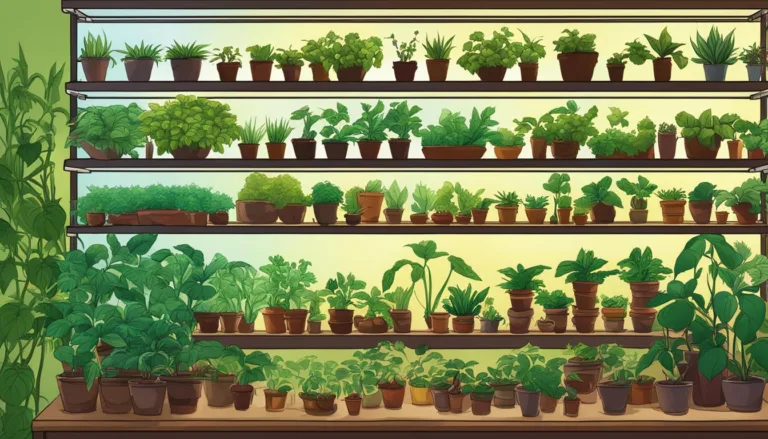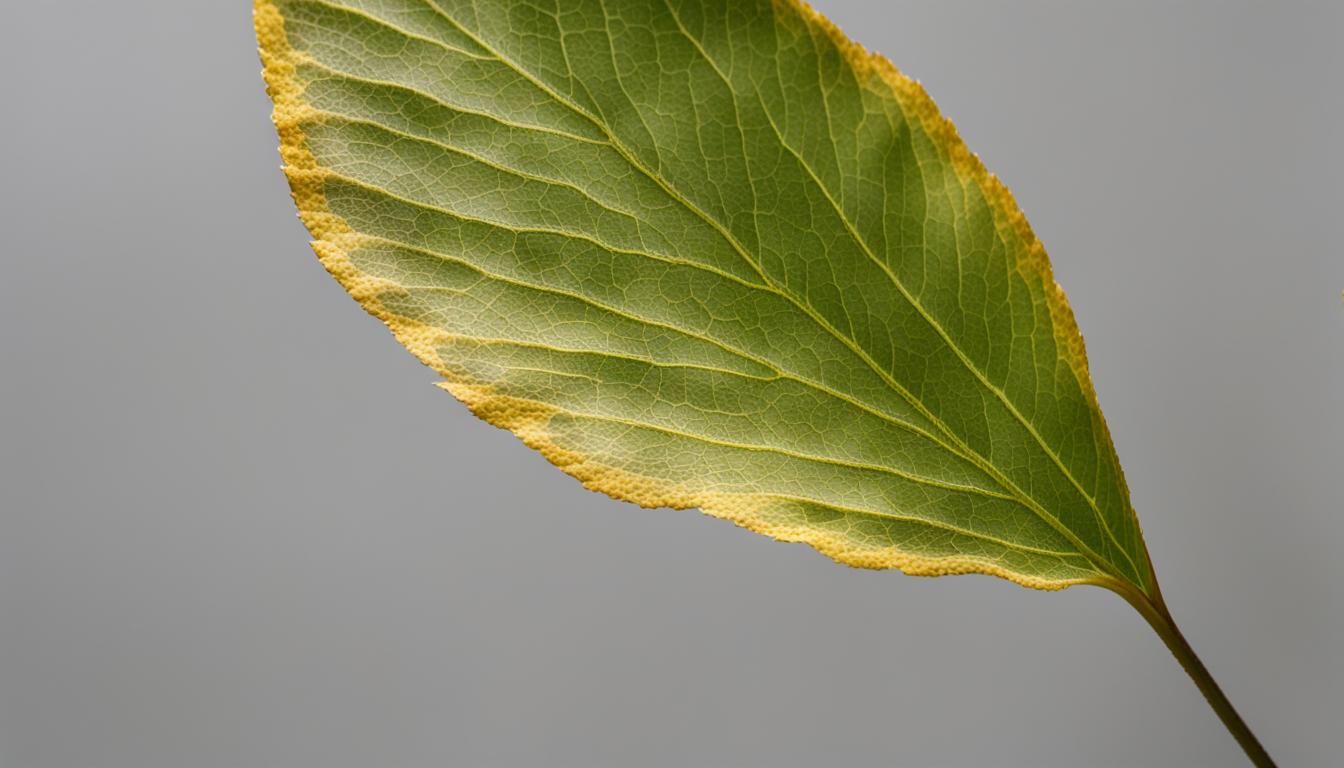
Copper deficiency in plants can have a detrimental effect on their growth and overall health. As an essential mineral, copper plays a vital role in various physiological processes, including photosynthesis and protein production.
When plants lack sufficient copper, they may experience stunted growth, yellowing leaves, and an increased susceptibility to stress and disease.
In this guide, I will provide valuable insights into diagnosing and treating copper deficiency in plants. We will explore the symptoms of copper deficiency, potential causes, and effective treatment options that can restore optimal copper levels in the soil and promote plant vitality.
We’ll discuss preventive measures to help you avoid copper deficiency in the future and the importance of copper in plant nutrition.
Key Takeaways:
- Copper deficiency in plants can lead to stunted growth, yellowing leaves, and signs of stress.
- Diagnosing copper deficiency involves observing symptoms and conducting soil and plant tissue tests.
- Preventing copper deficiency requires maintaining optimal soil conditions and avoiding heavy metal pollution.
- Treatment options include organic methods such as adding compost and chemical treatments like copper sulfate.
- Copper is crucial for photosynthesis, protein production, and overall plant health.
How to Diagnose Copper Deficiency in Plants
Diagnosing copper deficiency in plants is essential to address the issue and ensure healthy growth. By observing the signs and symptoms, gardeners can determine if their plants are experiencing copper deficiency. Some common signs of copper deficiency in plants include:
- Yellowing leaves
- Stunted growth
- Abnormal root growth
- Decreased crop yields
These symptoms can be caused by various factors, including environmental pollutants, low fertility levels, drought conditions, or inadequate irrigation.
To accurately diagnose copper deficiency, it is important to consider additional factors such as heavy metal pollution, soil fertility, and pH levels. Conducting soil and plant tissue tests can also provide valuable insights into the presence of copper deficiency.
Soil and Plant Tissue Tests
Soil testing involves analyzing the nutrient levels and pH of the soil. A laboratory test can give precise information about the copper concentration and help determine if it is deficient.
Plant tissue testing, on the other hand, involves analyzing the copper levels in the plant itself. This method provides a direct indication of the plant’s nutrient status and can help confirm the presence of copper deficiency.
By understanding the signs of copper deficiency and utilizing soil and plant tissue tests, gardeners can accurately diagnose the problem and take appropriate measures to address copper deficiency in plants.
How to Prevent Copper Deficiency in Plants?
Copper deficiency in plants can have detrimental effects on their growth and overall health. To ensure optimal plant nutrition and prevent copper deficiency, there are several key strategies that can be implemented:
1. Maintain Proper Soil Conditions:
Adding organic matter such as compost or manure to the soil can increase the availability of copper to plants. Organic matter contains essential nutrients, including copper, that can be slowly released into the soil over time.
It is recommended to incorporate organic matter into the soil before planting to provide a nutrient-rich environment for plant growth.
2. Monitor Soil pH Levels:
The pH of the soil plays a crucial role in the availability of copper to plants. Copper absorption is most efficient when the soil pH is within the appropriate range. Regularly testing the soil pH and making necessary adjustments can help ensure that plants receive an adequate supply of copper.
3. Practice Proper Irrigation:
Water management is essential for preventing copper deficiency in plants. Adequate irrigation ensures that plants receive sufficient water, which aids in the absorption of copper and other essential nutrients.
Overwatering can lead to nutrient leaching and poor copper availability. It is important to maintain a proper balance and avoid waterlogging the soil.
4. Avoid Heavy Metal Pollution:
Excessive heavy metal pollution in the soil can negatively impact copper availability to plants. Contaminants such as lead, zinc, and cadmium can compete with copper for absorption, leading to deficiency.
By minimizing heavy metal pollution through proper waste disposal and pollution control measures, plants can access an optimal amount of copper for healthy growth.
By implementing these prevention strategies, gardeners and farmers can create an environment that supports proper copper absorption and significantly reduces the risk of copper deficiency in plants.
Copper Deficiency Treatment for Plants
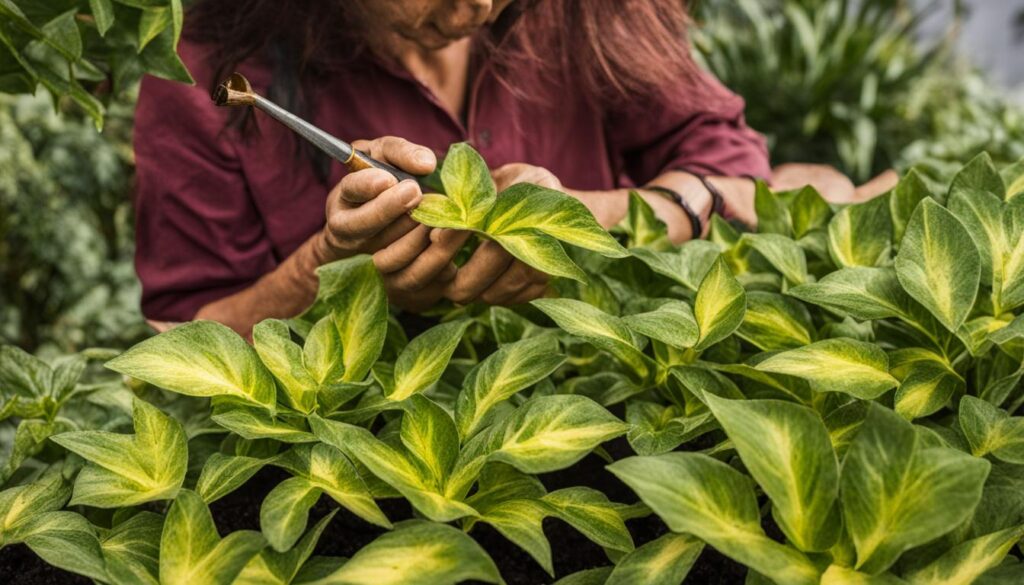
When it comes to treating copper deficiency in plants, there are various options that can be utilized. Organic methods involve incorporating compost, manure, or leaves into the soil to increase the amount of organic matter available, thus enhancing copper absorption.
Chemical treatments, on the other hand, may involve the application of copper sulfate or cupric oxide powder to the garden. It is crucial to follow the instructions and safety precautions provided when handling and using chemical treatments.
To determine the most suitable treatment for copper deficiency, it is advisable to conduct soil tests to assess metal concentrations and pH levels.
Organic treatments are favored by many gardeners due to their sustainable and environmentally friendly nature. Adding compost or manure to the soil not only improves copper availability but also enriches the overall nutrient content.
These organic materials release nutrients slowly, providing a long-lasting supply for the plants. Chemical treatments, however, can provide more immediate results when dealing with severe cases of copper deficiency.
Nonetheless, caution should be exercised as excessive use of chemical treatments can lead to copper toxicity or imbalance in the soil.
When considering treatment options, it is essential to evaluate the specific needs of your plants and the severity of copper deficiency.
Different plants may require different treatment approaches, and it is crucial to tailor the treatment accordingly. Some plants may respond well to organic methods, while others may require the additional assistance of chemical treatments.
Regular monitoring of plant health and growth is vital to determine the effectiveness of the chosen treatment and make any necessary adjustments.
Treatment Options for Copper Deficiency
Below is a summary of the treatment options commonly used for copper deficiency in plants:
| Treatment Method | Description |
|---|---|
| Organic Matter | Add compost, manure, or leaves to the soil to increase organic matter and improve copper absorption. |
| Chemical Treatments | Apply copper sulfate or cupric oxide powder to the garden, following instructions and safety precautions. |
| Soil Testing | Conduct soil tests to assess metal concentrations and pH levels for effective treatment planning. |
By utilizing these treatment options and closely monitoring the plants, copper deficiency can be effectively managed, promoting healthy growth and optimal nutrient absorption.
The role of copper in plant nutrition

Copper plays a crucial role in plant nutrition, as it is required for photosynthesis and the production of proteins. This essential mineral is involved in numerous enzymatic reactions that are vital for plant growth and development.
Copper acts as a cofactor for enzymes involved in the synthesis of chlorophyll, which is essential for the process of photosynthesis. Without sufficient copper, plants may experience yellowing leaves, reduced growth, and overall poor health.
One of the key functions of copper in plant nutrition is its involvement in electron transport chains, which are responsible for transferring energy and facilitating various metabolic processes.
Copper acts as an electron carrier, helping to generate adenosine triphosphate (ATP) – the energy currency of cells. This energy is vital for numerous physiological processes within plants, including the synthesis of proteins and the regulation of hormone levels.
Furthermore, copper is also crucial for the production and stability of plant cell walls. It plays a role in the formation of lignin, which provides structural support and protection for plant cells. Copper deficiency can lead to weakened cell walls, making plants more susceptible to diseases and environmental stressors.
Factors influencing copper availability in plants
The availability of copper to plants is influenced by several factors. Soil pH, for example, plays a significant role in copper uptake. Acidic soils with low pH levels can increase the solubility and availability of copper to plants.
On the other hand, alkaline soils with high pH levels can reduce copper availability. Therefore, maintaining an optimal soil pH range is crucial for ensuring adequate copper uptake by plants.
Organic matter also plays a vital role in copper availability. Copper is mainly found in organic compounds, and the decomposition of organic matter releases copper ions into the soil solution, making it more accessible to plants.
Incorporating compost or manure into the soil can help improve copper availability, especially in soils with low copper content.
In conclusion, copper plays a significant role in plant nutrition, supporting vital processes such as photosynthesis, protein synthesis, and cell wall development. Understanding the role of copper and its availability in soils can help optimize plant growth and health, ensuring the successful cultivation of crops.
Copper Deficiency in Specific Crops
When it comes to copper deficiency, specific crops can be particularly vulnerable. Cereal grains, such as wheat and barley, are commonly affected by this nutrient deficiency.
Farmers growing vegetables like onions, lettuce, and carrots must also be cautious, as these crops can suffer from copper deficiency as well. Even cannabis plants can experience copper deficiency, which can hinder their growth and reduce their ability to produce flowers.
Identifying copper deficiency in specific crops is crucial for effective treatment. By conducting soil and plant tissue testing, you can pinpoint whether copper levels are inadequate.
Once diagnosed, applying copper fertilizers can help address the deficiency in these crops. The application can be done through soil application or foliar spray, depending on the specific needs of each crop.
It’s important to consider the unique nutrient requirements and growing conditions of each crop when dealing with copper deficiency. Crop-specific solutions should be implemented to ensure optimal growth and productivity.
By addressing copper deficiency in these specific crops, farmers can promote healthy growth, prevent yield loss, and maximize their harvest.
FAQ
What are the symptoms of copper deficiency in plants?
Symptoms of copper deficiency in plants can include yellowing leaves, stunted growth, and signs of stress.
What causes copper deficiency in plants?
Copper deficiency in plants is often caused by a lack of available copper in the soil or water. It can also be caused by environmental pollutants, low fertility levels, drought conditions, or inadequate irrigation.
How can I diagnose copper deficiency in plants?
Diagnosing copper deficiency in plants involves observing symptoms such as yellowing leaves, stunted growth, abnormal root growth, and decreased crop yields. Soil and plant tissue tests can also be helpful in diagnosing copper deficiency.
How can I prevent copper deficiency in plants?
Preventing copper deficiency in plants involves maintaining optimal soil conditions. This can be done by adding organic matter such as compost or manure to the soil, monitoring soil pH levels, practicing proper irrigation, and avoiding heavy metal pollution.
What are the treatment options for copper deficiency in plants?
Treatment options for copper deficiency in plants include adding organic matter to the soil, using chelated forms or chemical treatments to add copper, and testing the soil for metal concentrations and pH levels to determine the appropriate treatment.
What is the role of copper in plant nutrition?
Copper plays a crucial role in plant nutrition as it is required for photosynthesis and the production of proteins. It is essential for healthy plant growth and optimal crop production.
Which specific crops are affected by copper deficiency?
Cereal grains, vegetables (such as onions, lettuce, and carrots), and cannabis plants are among the crops that can be affected by copper deficiency. Symptoms may include decreased growth, chlorosis, and the inability to produce grain or flowers.




